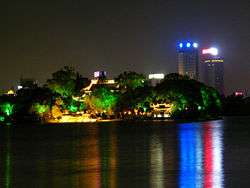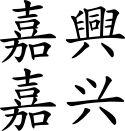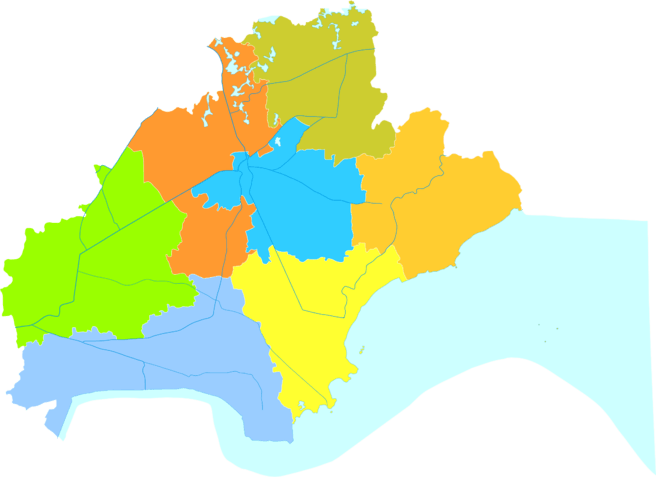Jiaxing
Jiaxing (Chinese: 嘉兴市; Wade–Giles: Chiahsing) is a prefecture-level city in northern Zhejiang province, China. Lying on the Grand Canal of China, Jiaxing borders Hangzhou to the southwest, Huzhou to the west, Shanghai to the northeast, and the province of Jiangsu to the north. At the 2010 census, its population was 4,501,657 and its built-up area made of 2 urban districts was home to 1,201,882 inhabitants.[1]
Jiaxing system began in Qin Dynasty and has a history of more than two thousand years. Jiaxing since ancient times as a prosperous and rich land, known as the "land of plenty", "Silk City" reputation, is a national historical and cultural important city.
Administration
As of December 30, 2015, Jiaxing has jurisdiction over 2 municipal districts (Nanhu District, Xiuzhou District), 3 county-level cities (Haining, Pinghu and Tongxiang) and 2 counties (Jiashan county and Haiyan County). A total of 44 towns, 29 streets (agriculture related Street 22), 246 urban communities, 115 urban communities, 809 administrative villages.
In 1949, Jiaxing County, Jiaxing City, respectively, after merging frequently. In August 1983, the administrative office of the Jiaxing area was revoked, divided into Jiaxing and Huzhou, and Jiaxing city and suburbs. Under the jurisdiction of Jiashan, Pinghu, Tongxiang, Haining and Haiyan, 5 counties were administered. In November 1993, the city of Jiaxing was renamed "show city". In June 21, 1999, the suburbs changed its name to Xiuzhou district. In 2005, the city of Jiaxing changed its name to Nanhu Lake district.
| Map | ||
|---|---|---|
| Subdivision | Hanzi | Pinyin |
| Nanhu District | 南湖区 | Nánhú Qū |
| Xiuzhou District | 秀洲区 | Xiùzhōu Qū |
| Jiashan County | 嘉善县 | Jiāshàn Xiàn |
| Haiyan County | 海盐县 | Hǎiyán Xiàn |
| Haining | 海宁市 | Hǎiníng Shì |
| Pinghu | 平湖市 | Pínghú Shì |
| Tongxiang | 桐乡市 | Tóngxiāng Shì |
These are further divided into 75 township-level divisions, including 60 towns, 2 townships and 13 subdistricts.
History

Known as a place
- Spring and Autumn period: Jiaxing is known as Zuili (Drunken Plums) and is an important city in the state of Yuè.
Known as a county
- 210 BC: Qin Shi Huang changed the name of Jiaxing from Changshui District (長水縣) to Youquan (由拳縣).
- 231: Wild rice (野稻) of Jiaxing informed Sun Quan of the Kingdom of Wu that there was a sign of auspice, so Sun changed Youchuan to Hexing District (禾興縣). This why Jiaxing's abbreviation is He. Sun also changed his era name to Jiahe (嘉禾) in the following year.
- January 242: Sun He was made the crown prince. Because of the naming taboo, Jiahe was changed to Jiaxing.
Known as a prefecture
- 938: (Later Jin of the Five Dynasties): Xiu Prefecture (秀州) established
- 1117: (Song Dynasty): Jiahe District (嘉禾郡)
- 1429: (Ming Dynasty): Xiushui District (秀水縣) was established northwest of Jiaxing.
- Early 1900s (the Republic of China): Xiushui and Jiaxing were combined into Jiahe County
- 1914: Reverted to Jiaxing County (because there's a Jiahe in Hunan)
- 1921: Communist Party of China founded at the South Lake in Jiaxing.
- 1926: Following the defection of Zhejiang civil governor Xia Chao to the Kuomintang during the Northern Expedition, the army of warlord Sun Chuanfang completely defeats Xia's largely untrained army at Jiaxing. Xia is captured and executed shortly thereafter.[2][3]
- 1949 − 1958, 1979 (PRC): Upgraded to a city
- 1981: Old Jiaxing County merged into the city
- 1983: Upgraded to prefecture-level city
Economy
Industry is the main economic driver to the city’s economy, contributing 47% to its GDP in 2015. Jiaxing is also well known as the 'hometown of silk', hence it is a famous producer of textiles and woolens. It is one of the world's largest exporters of leather goods. There are mechanical, chemical and electronic industries there.
Jiaxing is an important energy base in East China. Qinshan Nuclear Power Plant, the first self-designed nuclear power station in China, and Fangjiashan Nuclear Power Plant (under construction) are located in Haiyan County.
South Korean tire maker Hankook Tire has a production facility in Jiaxing Development Zone for cars and light trucks. Hankook Tire (Jiaxing) Co., Limited was opened in 1996.[4]
A Lego factory was built and finished in 2015, specially for the Asian market.[5]
In 2013, the GDP was 314 billion 766 million yuan, an increase of 9.3% over the previous year, an increase of 0.6 percentage points over the previous year. Among them, the first industry added value of 15 billion 562 million yuan, an increase of 0.8%; second industrial added value of 172 billion 673 million yuan, an increase of 9.9%; third industry added value of 126 billion 531 million yuan, an increase of 9.4%. According to the resident population, the per capita GDP of 69164 yuan (annualized average exchange rate of 11169 U. S. dollars), an increase of 8.9%. The three industrial structure was adjusted from 5.2:55.5:39.3 to 4.9:54.9:40.2 last year.
Jiaxing's general budget revenue of 51 billion 749 million yuan, an increase of 9.7% over the previous year, of which the public budget revenue of 28 billion 231 million yuan, an increase of 9.5%. Fiscal expenditure for people's livelihood at various levels was 22 billion 679 million yuan, an increase of 18.9%.
Industrial zone
Jiaxing Export Processing Zone
Established in 2003, Jiaxing Export Processing Zone is a state-level export processing zone approved by State Council. It has a built-up area of 2.98 km2. Its development goal is to become the export processing base for IT, IC, mechanical and electrical, electronics and other high-tech industries.[6]
Tourism
Jiaxing is an excellent tourist city and a national garden city in China. It is a famous historical and cultural city with a typical Jiangnan Water and customs style. It has become a unique feature of Jiaxing given by the ancient simplicity and relaxation for more than 2600 years. As of 2016, Jiaxing city has the national AAAAA level scenic spots 3 (Wuzhen, South Lake, Xitang), and the number of the capital city of Hangzhou province are the first level, the national AAAA level scenic spots 3, 1 AAA level scenic spots, national key cultural relics protection unit 6.
- South Lake, where the Communist Party of China was officially founded.
- Wuzhen is located in Jiaxing City, Zhejiang Province, Tongxiang. It is west of Huzhou City, the northern boundary of Jiangsu, Suzhou City, Wujiang District, and is the junction of the two provinces and three cities. Wuzhen has a long history of more than six thousand years. It is one of the twenty golden week forecast scenic spots and one of the six ancient towns in the south of china. Wuzhen is a typical Han ancient town in Jiangnan area, there is "plenty of silk", is the national AAAAA level scenic spots. Wuzhen from the beginning of November 19, 2014, as the permanent site of the world Internet conference.
- The ancient town of Xitang is located in Jiashan County, Jiaxing City, Zhejiang province. It is located at the junction of Jiangsu, Zhejiang and Shanghai provinces. It is one of the six ancient towns in the south of the Yangtze river. East 90 kilometers away from Shanghai, 110 kilometers west of Hangzhou, 85 kilometers north from Suzhou. Xitang has a long history, rich in human resources, natural scenery, is one of the birthplace of ancient Wu Yue culture, is a national AAAAA class tourist attractions, the most water charm film and television base. In 2003, it was included in the first batch of Chinese historical and cultural towns. In 2011, it was listed as a list of world cultural heritage by UNESCO, and was awarded the outstanding achievement award of history and culture protection by the United nations.
Transportation
The city is served by two railway stations: Jiaxing Railway Station, on the Shanghai–Kunming Railway, and Jiaxing South Railway Station on the high speed Shanghai–Hangzhou Passenger Railway.
The city is served by two long-distance bus stations: Jiaxing North Bus Station and the new Jiaxing Transportation Center.
Jiaxing is on the G92 Hangzhou Bay Ring Expressway, G60 Shanghai–Kunming Expressway and China National Highway 320.
Jiaxing's local air force base is being converted to a public-use airport.[7] Jiaxing an hour to Shanghai Hongqiao International Airport, Shanghai Pudong International Airport, Hangzhou Xiaoshan International Airport and other airports.
The Beijing-Hangzhou Grand Canal runs across Jiaxing.At the beginning of the last century, San yat-sen went to Jiaxing Pinghu area Zhapu investigation, and in the "nation building strategy" in the construction of this "Oriental port plan". Zhapu Port built into the only river transport in Hong Kong, Jiaxing port in April 2001 formally as a kind of port opening. Jiaxing port has 10 offshore berths, of which 10000 ton berths 6, kiloton berths 4, the annual handling capacity of 15 million tons. In 2011, Jiaxing port completed a total cargo throughput of 52 million 580 thousand tons.
Language
Jiaxing dialect is a Northern Wu dialect in the Sujiahu dialect grouping. As such, it is a sister dialect of both Shanghainese and Suzhou dialect, and easily intelligible with both. It is not mutually intelligible with Mandarin or other varieties of Chinese such as Cantonese or Hakka.
Notable people
- Zhu Yizun (朱彝尊), scholar and poet
- Wang Guowei (王国维), scholar, writer and poet
- Xu Zhimo (徐志摩), poet
- Shiing-Shen Chern (陈省身), mathematician
- Mao Dun (茅盾. or 沈德鴻, or沈雁冰), novelist, critic, journalist
- Zhang Yuanji (张元济), publisher
- Zhang Zhongjun (张钟俊), scientist
- Xu Kuangdi (徐匡迪), scientist, politician
- Zhu Shenghao (朱生豪), translator
- Zhang Leping (张乐平), cartoonist,Its cartoon character Sanmao is well known in China
- Yang Borun (杨伯润), poet, calligrapher, painter
- Jin Yong (金庸), novelist
- Fan Xiping (范西屏), Go player
- Miao Huixin (), artist
- Shen Junru (沈钧儒), politician, patriot
- Wu Outing (吴藕汀), poet, painter, culture scholar
- Yu Dafu (郁达夫), author
- Zhou Hanming (), mathematician
- Jeremy Lin (林书豪), ancestral home, athlete of the Charlotte Hornets
See also
References
- ↑ "China: Administrative Division of Zhejiang (Prefectures, Cities, Districts and Counties) - Population Statistics in Maps and Charts".
- ↑ Jordan (1976), p. 91.
- ↑ Smith (2000), p. 149.
- ↑ "Hankook Tire (Jiaxing) Co., Ltd. in Jiaxing, Zhejiang, CN".
- ↑ Trangbæk, Roar Rude. "LEGO Group to build factory in China - About Us LEGO.com".
- ↑ "Welcome RightSite Visitors". 5 June 2016.
- ↑ Li Zhongyang (利众羊). 嘉兴要建民营飞机场 (in Chinese). 0573ren.com. Retrieved 7 May 2012.
Bibliography
- Jordan, Donald A. (1976). The Northern Expedition: China's National Revolution of 1926-1928. University Press of Hawaii. ISBN 9780824803520.
- Smith, Stephen Anthony (2000). A Road Is Made: Communism in Shanghai, 1920-1927. Honolulu: University of Hawaii. ISBN 9780824823146.
External links
| Wikimedia Commons has media related to Jiaxing. |

- Government website of Jiaxing (in English)




